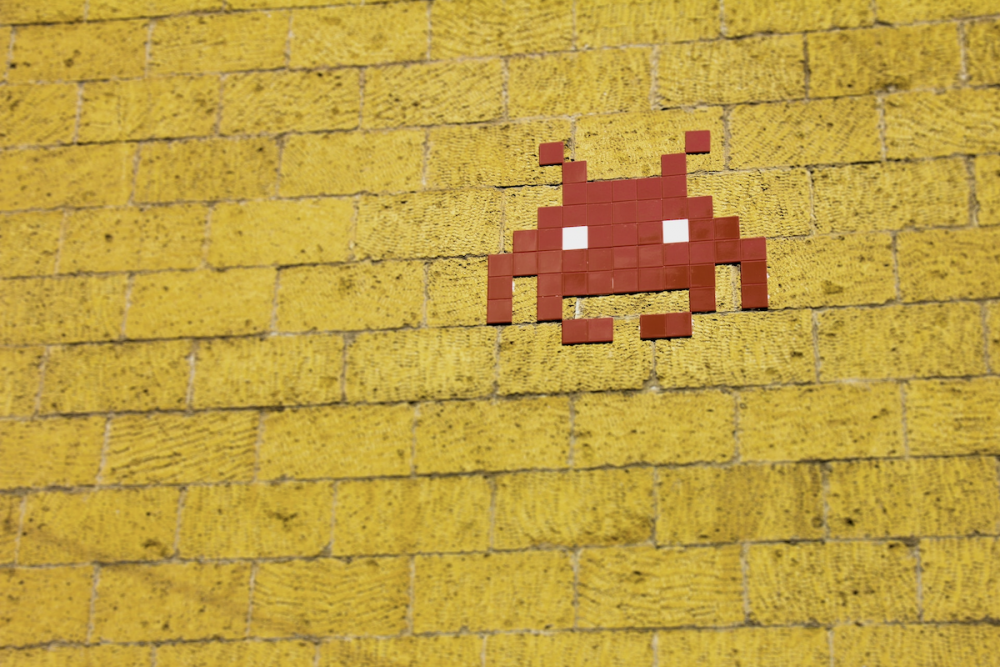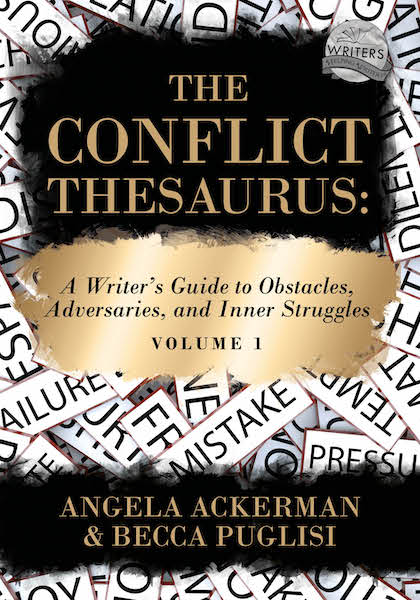
Todays post is by Angela Ackerman (@AngelaAckerman), co-author of The Conflict Thesaurus: A Writer’s Guide to Obstacles, Adversaries, and Inner Struggles (Volume 1).
Is there anything better than well-written conflict? The vengeful enemy, sharks circling the sinking boat, a carefully guarded secret getting out in the open.
Readers, fearful for the characters they love, grip the book tighter when conflict is close.
What will happen? Will everything be okay?
The more dire the threat, the more uncertain they feel.
Conflict holds power in storytelling because it touches everything: pacing, plot, stakes, characterization, character arc, emotion, you name it. Internal or external, subtle or obvious, readers invested in the book will find themselves in a near-constant state of tension as they worry about the character’s ability to dodge story knives.
One of the biggest sources of conflict comes in the form of an adversary—someone (or something) that has goals, needs, desire, or a purpose that clashes with the protagonist’s own. Once their paths cross, BOOM. Friction, tension, conflict! A battle of wills, might, and minds ensues until one is victorious.
Adversaries generate a lot of conflict, meaning it’s important to know their motivations and intentions. If they have a big role, we should brainstorm them just as we would the protagonist (here’s a tool to help with that) to understand what’s driving them. But are all adversaries the same? Not at all. Depending on what you need, you have a variety of adversarial players to choose from. Here are some considerations for each.
Competitor: This foe is someone who has the same goal as the protagonist and will compete for it. Whether your character is up against a peer for a scholarship, a job, an award, or something else, make sure their competitor has abilities, skills, resources, or other assets that will make the outcome uncertain.
Rival: Like a competitor, this opponent wants the same thing as your protagonist. What’s different though is that the rival is also invested in defeating the protagonist. The victory is personal because there’s some sort of history between the two.
Consider the ongoing friction between Johnny Lawrence and Daniel LaRusso (and, later, their competing dojos) in the TV series, Cobra Kai. Johnny and Daniel took very different paths since their initial battle in The Karate Kid. Daniel became a wealthy and successful businessman while Johnny worked handyman jobs and flirted with alcoholism as an escape from his personal failings, losses, and abuse trauma. Old wounds are reopened when Johnny reopens Cobra Kai to empower youths, and Johnny’s son trains with Daniel to get back at his dad. Further complications abound as their teenage kids start dating and Johnny fights to become someone better while Daniel holds firm to old biases. The result of all this friction? A boatload of rivalry-fueled conflict.
Antagonist: This is often a catchall term for the main adversary. If the antagonist is a person, they will have a mission or agenda that counters the protagonist’s and most likely are prominent enough to have a character arc of their own.
Antagonist Force: The foe standing between your character and their goal doesn’t need to be a person. Depending on the story, the antagonistic force could be an element of nature (the brutal polar vortex in The Day after Tomorrow), an animal (the wolf pack hunting plane crash survivors in The Grey), or even a type of technology (The Terminator).
Villain: A villain is different than an antagonist in the sense that there is an element of evil or a specific intent to hurt others. Something has skewed their worldview and made them into who they are—a person whose moral code runs on a completely different track. Villains have no qualms about mowing down anyone who gets in the way of their goal.
Enemy: This type of foe is a threat to your protagonist and those they’re aligned with. An enemy can be a person, collective, family, or even a concept that threatens to do great damage. If the enemy is someone your character once had an amicable relationship with, the moment the two choose opposition, previous attachments are cast aside.
Invader: Some people are all about disrupting the status quo; they want what others have—be it land, power, resources, or lives—and are there to take it. Invaders are the aliens in Independence Day, the death-eaters laying siege to Hogwarts, and the highwaymen from Alas, Babylon.
Frenemy: This adversary is someone your character may align with at times, but a competition exists that requires an emotional shield to always be in place. Frenemy relationships are often between peers (co-workers, members of the same social clique, etc.), and peace is kept if conditions remain stable. As soon as one character’s position is elevated (they’re given more attention, an advantage, offered an opportunity, etc.), the competition is on. Frenemy relationships are prone to jealousy and so can devolve quickly.
Hater: This character is someone who sees your protagonist as being undeserving of the good that comes to them. In general, haters struggle with the success of others, possibly due to envy, jealousy, and feelings of personal inadequacy. Haters are disruptors and saboteurs who look for opportunities to cause problems and “take someone down a peg.”
Bully: This opponent gains power by controlling others. Bullies can exist in any environment, from the mean-spirited boss who enjoys pushing your character around, to the adult sibling that never lost his adrenaline rush at sliding the brotherly (or sisterly) knife in. The closer a bully is to your character, the more they can exploit their weaknesses.
Aggressor: Some who struggle to manage their feelings have a go-to response to discomfort or fear: aggression. When a threat is perceived, the aggressor responds impulsively, using intimidation, verbal and emotional abuse, or violence to neutralize the threat. Aggressors are volatile and dangerous because once triggered, they don’t back down.
Meddler: Chances are, some people around your character have strong opinions and aren’t afraid to share them. But if they consistently try to insert themselves or interfere, they become meddlers. This type is somewhat passive-aggressive, offering unsolicited feedback and intrusive advice—or, worse, actively interfere to achieve a specific end. Meddlers are those the character has an emotional attachment to, so rather than directly calling them out, your character may put up with it until they eventually explode.
Nemesis: Once in a great while an adversary comes along who is powerful, relentless, and enduring. This is a foe that, to date, has not been bested and so their very presence is a thorn your protagonist obsesses over but can’t remove. Superman has Lex Luther, Harry Potter has Voldemort. Both parties long for the destruction or removal of the other but have been unable to bring that about.
Challenger: Sometimes your character is at the top of the food chain—happy, secure, and in control. They might be the director of an important area of the government, have the most prosperous grocery store in town, or they’re dating the prom queen. In other words, life is good. Enter the challenger—someone in a position to take what your character has.
Supernatural Force: Inhuman adversaries present a specific challenge because they usually have powers and abilities your protagonist does not. This makes the matchup uneven and will require your character to rethink what they know and believe to find a way to overcome this threat.
Adversarial conflict can be direct or indirect, but always requires a reason for existing.
Choosing an antagonist just because your character “needs someone to beat” will lead to hollow conflict, so develop each character to unearth their why instead. Who has something to prove and why? Is this about payback or something else? Is a belief or identity on the line? Adversary or protagonist, when readers can clearly line up the character’s motivation to their goals and needs, it gives credibility to their actions, choices, and behavior.
Need more ideas? You’ll find problems, obstacles, ticking clocks, temptations, moral dilemmas and more in The Conflict Thesaurus: A Writer’s Guide to Obstacles, Adversaries, and Inner Struggles (Volume 1). Here’s a list of the conflict scenarios covered in this book. Let the conflict brainstorming begin!


Ordered! Looking forward to receiving my copy. Thank you for this great summary.
I hope you love it, N.J.! Conflict is a great way to make our stories meaningful and fresh when we think carefully about what to include and why it impacts the protagonist. 🙂 Happy writing!
Thanks so much for having me by, Jane! I feel like on a post about adversaries I probably should add an evil laugh, so here it is: Muahahaha!